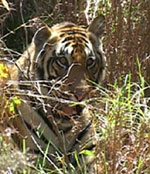Dr. SHOMITA MUKHERJEE
 graduated from St. Xavier’s college, Mumbai in 1987 in Zoology, Biochemistry and Entomology. For her post graduation she joined the Wildlife Science course at the Wildlife Institute of India in 1988. Her Master’s dissertation was
on three small carnivores, the jungle cat, fishing cat and golden jackal in Keoladeo Ghana National Park, Bharatpur. After post graduation, she went on two surveys, one to Arunachal Pradesh to look for the Takin and the other to the Dang forests of Gujarat
for the rusty spotted cat. Her other research projects include standardizing laboratory techniques to study large carnivore diet at the Wildlife Institute of India and studying diet and habitat use in jungle cat, caracal and golden jackal in Sariska Tiger
Reserve. The latter led to her Ph.D. degree. She had a short stint at the Policy Research Cell at the Wildlife Institute of India and was later employed by the Wildlife Trust of India, Delhi and Tiger Watch, Ranthambhor. Currently she is writing a proposal
that aims to explore the utility of non-invasive DNA analysis in addressing questions related to small carnivore ecology. Though her chief interest lies in the ecology of small cats, she is also planning a project on the leopards of Sanjay Gandhi National
Park in Mumbai along with some other friends.
graduated from St. Xavier’s college, Mumbai in 1987 in Zoology, Biochemistry and Entomology. For her post graduation she joined the Wildlife Science course at the Wildlife Institute of India in 1988. Her Master’s dissertation was
on three small carnivores, the jungle cat, fishing cat and golden jackal in Keoladeo Ghana National Park, Bharatpur. After post graduation, she went on two surveys, one to Arunachal Pradesh to look for the Takin and the other to the Dang forests of Gujarat
for the rusty spotted cat. Her other research projects include standardizing laboratory techniques to study large carnivore diet at the Wildlife Institute of India and studying diet and habitat use in jungle cat, caracal and golden jackal in Sariska Tiger
Reserve. The latter led to her Ph.D. degree. She had a short stint at the Policy Research Cell at the Wildlife Institute of India and was later employed by the Wildlife Trust of India, Delhi and Tiger Watch, Ranthambhor. Currently she is writing a proposal
that aims to explore the utility of non-invasive DNA analysis in addressing questions related to small carnivore ecology. Though her chief interest lies in the ecology of small cats, she is also planning a project on the leopards of Sanjay Gandhi National
Park in Mumbai along with some other friends.
“The naming of cats is a difficult matter.
It isn’t just one of your holiday games;
You may think at first I’m mad as a hatter
When I tell you, a cat must have THREE DIFFERENT NAMES…..”
So said T. S. Elliot *, and how right he was. Though he was referring to our sometimes friendly neighbourhood cat, this also applies to its 36 wild cousins. While not exactly what Elliot meant, they do have three names: the generic,
specific and common. Many a taxonomist has torn his/her hair over getting cat taxonomy right. Why do cats baffle us?
 The order Carnivora (meat eating mammals), has 10 Families e.g. Canidae (dogs), Felidae (cats), Herpestidae (mongoose) etc., with many also including large quantities of fruits and seeds in their diet. However, the family Felidae
is unique, with all its members being “obligate carnivores” that cannot survive without meat. With their peculiar physiology they rely on meat for certain nutrients that other mammals like us assemble within our body with precursors. Their diet is high in
protein and fat with almost no carbohydrates while their body, skull and teeth shaped to extreme specialization, function exclusively to kill.
The order Carnivora (meat eating mammals), has 10 Families e.g. Canidae (dogs), Felidae (cats), Herpestidae (mongoose) etc., with many also including large quantities of fruits and seeds in their diet. However, the family Felidae
is unique, with all its members being “obligate carnivores” that cannot survive without meat. With their peculiar physiology they rely on meat for certain nutrients that other mammals like us assemble within our body with precursors. Their diet is high in
protein and fat with almost no carbohydrates while their body, skull and teeth shaped to extreme specialization, function exclusively to kill.
One striking feature about this family is that though sizes vary almost 200 fold (the 1 kg black-footed and rusty-spotted cats to the 200 kg tiger and lion) the general appearance is the same. Anyone can tell that a tiger is just an
enormously large cat. This, some scientists believe is an outcome of their extreme specialization. Though canids and felids have diverged around the same evolutionary time scales and currently have around the same number of species (Canids: 35, Felids: 36),
cats have retained their likeness while dogs come in many forms with some hardly resembling “dogs” (I mean species and not breed -though even here dogs have so much more diversity in form that cats do)!. This could be one of the features responsible for agonizing
taxonomists.
Indians should be proud of the fact that as a country we are the richest in cat species, having 15 of its members. All except the jungle cat figure in Schedule I of the Indian Wild Life Act. What we certainly should not be proud of is
the fact that most (if not all) felids in India are threatened by habitat loss, poaching or both. We drove the cheetah to extinction and by our apathy promise to do so with its other relatives as well. Little is known of most wild felids we have in our country.
Unless appallingly ignorant, everyone has heard of tigers, lions and leopards but even the most educated may not have heard of the caracal, the rusty spotted cat or for that matter the most common wild felid in India – the jungle cat. My next article will
be dedicated to this intriguing species.
( photo: Tiger in Kanha National Park, Susan Sharma)
* T.S. Elliot (1939). Old Possum’s book of practical cats. Faber and Faber Limited, London.